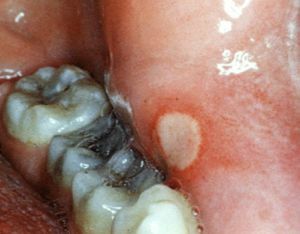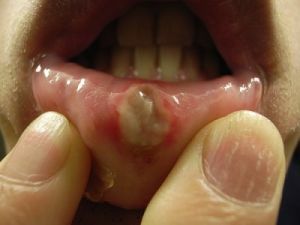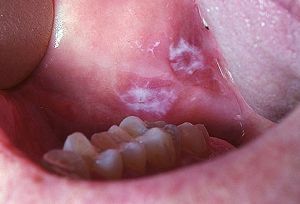 Traumatic stomatitis is an inflammatory disease of the oral cavity, which develops against a background of prolonged traumatic effects on the mucous membrane.
Traumatic stomatitis is an inflammatory disease of the oral cavity, which develops against a background of prolonged traumatic effects on the mucous membrane.
Oral cavity is covered with epithelial tissue of non-keratinizing nature with a large number of glandular cells. The mucous membrane has a high regenerative capacity, and the saliva produced by the salivary glands has antibacterial properties.
This disease develops on the background of prolonged exposure to irritant factors or massive traumatic damage to the oral tissue.
Traumatic stomatitis can develop at any age and the causes are almost always the same, but children tend to have this disease more often, which may be due to an increased frequency of microtraumas.
Contents
- Etiological factors of the development of the disease
- Features of somatic manifestations
- Features of medical treatment
- About children talk separately
- Preventative measures
- Complications of the disease
Etiological factors of the disease development
Etiological factors of the disease development are subdivided depending on the species characteristic.
The most common reasons are:
- Mechanical traumatic damages .This type of trauma is most common in childhood, due to biting hard objects or ingesting solid foods. Children often bite the internal
 surface of the lip, which further contributes to the penetration of the infection.
surface of the lip, which further contributes to the penetration of the infection. - Chemical damage to can develop due to the use of concentrated solutions of irritant action, prolonged use of alcohol substitutes or smoking tobacco. If microtrauma is already present on the mucous membrane, tobacco slows down the regeneration process and accelerates the progression of the disease. Combinations of injuries and chemical effects increase the risk of oral cancer.
- Thermal effects of as a result of consuming hot food or liquids. Very rare cases of frostbite of the oral mucosa.
The most frequent localization of the lesion is teeth, the inner surface of the upper and lower lips, tongue and soft palate. In children, traumatic stomatitis is in most cases localized on the inner surface of the lower lip.
Features of somatic manifestations
Traumatic stomatitis differs from other types of inflammatory diseases of the oral cavity in that the pathological focus has a localized character at the place of traumatic impact.
Basic complaints of patients:
- pain and burning sensation when eating;
- bad breath;
- general malaise, as a consequence of the inflammatory process in the body.
When objective examination of such patients in the oral cavity, specific changes are detected, among which:
- pronounced puffiness, reddening of the mucosa;
- erosive and ulcerative formations;
- hypertrophic degeneration of epithelial cells;
- sites of necrosis and keratinization of cellular structures;
- increase in the size of regionally located lymph nodes.
Laboratory and instrumental diagnostic methods for traumatic stomatitis, as a rule, are not carried out, since the final diagnosis can be made on the basis of an objective examination and collection of an anamnesis of the disease.
Features of medical treatment
 First of all, the treatment of traumatic stomatitis should be aimed at eliminating the etiological factor provoking the development of the disease.
First of all, the treatment of traumatic stomatitis should be aimed at eliminating the etiological factor provoking the development of the disease.
If the cause of stomatitis is carious lesions of the teeth, they are removed with a sanitizing focus of infection.
To treat the disease, the following methods are used:
- pain relief with local topical pain medication;
- mechanical cleaning of the oral cavity from plaque and other contaminants, grinding of sharpened teeth;
- for the sanitation of the oral cavity from bacterial pathogens used antiseptic solutions with a local mechanism of action;
- cupping of the inflammatory process in the oral cavity with the help of non-steroidal anti-inflammatory drugs;
- a course of vitamin therapy and local application of oil solutions to the mucous membrane to accelerate the regeneration processes.
For topical use, such medications are used:
- solution of Furacilin;
- Chlorhexidine;
- solution of baking soda;
- solution of hydrogen peroxide.
All these preparations have antiseptic and antibacterial properties, improve local microcirculation, and also contribute to the enhancement of regeneration processes.
People who are prone to treatment with natural medicines can use infusions and decoctions of chamomile, sea buckthorn, oak bark or calendula.
About children we will talk separately
To treatment of traumatic stomatitis in children it is necessary to approach very carefully, as the children's organism is very gentle and sensitive to some preparations.
The main goal of treatment measures is based on the prevention of the spread of infection in the oral cavity, using antiseptic solutions and infusions from medicinal plants.
Anti-inflammatory and antibacterial drugs are used only in the form of topical application, the most frequently used are solutions: Lugol, Hexaliz, Kholisal, Miramistin and others. These drugs are hypoallergenic, do not cause irritation and complications, are widely used in pediatric practice.
Dr. Komarovsky pro-stomatitis in children, his symptoms and treatment:
Preventive measures
An important link in the prevention of stomatitis is the avoidance of traumatic effects on the oral mucosa, in particular, it is not recommended to drink excessively hot drinks, substances of unknown origin.
Oral cavity is considered an external environment and 100% of all microtraumas can not be avoided exactly, the main task in such cases is to prevent the spread of infection and further progress of the inflammatory process.
 The development of inflammation can also be provoked by bacteria that make up a normal microflora, so if they increase their accumulation, they can become pathogenic. To prevent the development of such a process, it is recommended to regularly perform hygienic cleaning of teeth, preferably after each meal.
The development of inflammation can also be provoked by bacteria that make up a normal microflora, so if they increase their accumulation, they can become pathogenic. To prevent the development of such a process, it is recommended to regularly perform hygienic cleaning of teeth, preferably after each meal.
In the event that a traumatic effect has already occurred, the damaged area must be treated in a timely manner with antiseptic or antibacterial drugs.
Complications of the disease
Complications develop as a consequence of neglected pathological condition and incorrectly conducted conservative therapy.
The most common consequences are:
- bad breath odor from the oral cavity;
- discomfort and burning pain in the affected area;
- systemic inflammatory process;
- papillomatous overgrowth of glandular epithelium;
- necrotic tissue sites with complete loss of cell viability.
A very rare and extremely severe complication is a common blood infection and septic shock.
